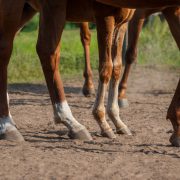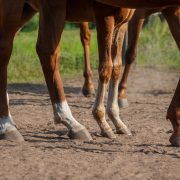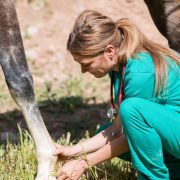Incidence and risk factors of surgical site infection and septic arthritis after elective arthroscopy in horses
Incidence and risk factors of surgical site infection and septic arthritis after elective arthroscopy in horses

Requires membership/payment
This article can be accessed via RCVS Knowledge Library Membership (click here).
In our edition of: Feb 2018
In our categories of: equine
our summary:
Brunsting, J.Y. et al. (2017) Incidence and risk factors of surgical site infection and septic arthritis after elective arthroscopy in horses. Veterinary Surgery, 47(1), pp. 52-59
Elective arthroscopy is generally associated with a low risk of complications; the most common postoperative complications include infections either as a surgical site infection (SSI) and/or septic arthritis.
The aim of this retrospective case study was firstly to evaluate the incidence of SSI or septic arthritis following elective arthroscopy and secondly to identify the risk factors for SSI and septic arthritis.
Medical records of horses that underwent elective arthroscopy between 2006-2013, at a single equine hospital, were reviewed. Horses were selected for the study if they had joints free of local corticosteroids for at least 6 weeks prior to surgery. The size of the osteochondral and subchondral lesions were recorded: as small <20 mm in length; medium between 20 – 40 mm; and large >40 mm in length.
All horses included in the study were subjected to the same surgical and postoperative protocols, were box-rested for a minimum of 2 weeks and then 4 weeks of box-rest combined with hand walking exercise. In addition, stifle joints with large subchondral lesions had a further 3 months of exercise restriction.
The study analysed a total of 1741 operated joints from 1079 horses predominantly Warmbloods. Of the operated joints, there were 48 coffin, 720 fetlock, 17 carpal, 2 shoulder, 539 tarsal, 359 femoropatellar and 56 femorotibial joints. 1322 joints were categorised as having small lesions, 264 with medium and 87 as having large lesions.
1.76% (19/1079) horses had a SSI, septic arthritis, or both. 0.65% (7/1079) horses developed SSI without septic arthritis; 1.11% (12/1079) horses developed septic arthritis.
The risk of SSI was higher in horses with lesions size >40 mm, possibly due to the fact that removal of large lesions requires more extensive manipulation of soft tissues and repeated introduction of surgical instruments through the portal. Since large lesions were predominantly present in femoropatellar joints this joint should be considered at an increased risk for a SSI.
There was a strong association between SSI and septic arthritis with the results indicating that SSI is the primary complication leading to septic arthritis which is secondary. The risk of infection decreased with age, which may be related to the amount of time spent in recumbency, this in turn may be associated with contamination of the portals after discharge.
The retrospective design of the study was a limitation however the authors consider that the large sample size and multivariate analyses of risk factors provided adequate statistical power.
Arthroscopic removal of large lesions carries an increased risk of postoperative surgical site infection which may lead to septic arthritis. As large lesions are mainly found in the femoropatellar joints, this joint is predisposed for a SSI after arthroscopy.
The risk of postoperative infection decreased with age, possibly due to the higher risk of postoperative contamination of the portals i.e. when the horse is in recumbent after surgery, in younger horses where discharge protocols are harder to follow. Preventative steps should be taken to minimise this risk.
Image copyright attribute:
djakob / 123RF Stock Photo







Leave a Reply
Want to join the discussion?Feel free to contribute!